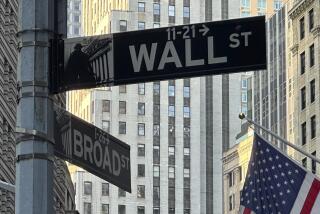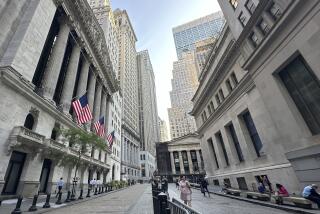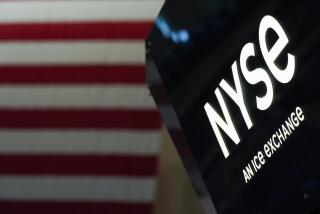U.S. Growth Gives New Life to Dollar Rally
Bond and stock markets may be having trouble dealing with the U.S. economyâs surprising resilience, but the dollar is gaining from it.
That is definitely good for Americans headed abroad this spring or summer, probably good for foreign stock markets, but potentially problematic in the short run for U.S. multinational companiesâ stocks.
The buck surged to a 26-month high against the Japanese yen on Tuesday, and climbed sharply against major European currencies as well, as traders poured into the dollar, betting on a continuing advance.
At 108.30 yen Tuesday, up from 107.75 on Monday, the dollar is up 4.7% since year-end. Against the German mark, the dollar jumped to 1.498 marks Tuesday, up from 1.482 Monday, bringing its year-to-date gain to 4.2%.
Compared with its levels versus the yen a year ago--when a dollar bought a record low 80 yen--the U.S. currency looks like a rocket. But in fact, the dollarâs trend over the last year has been sharply higher only against the yen and the Mexican peso. Its gains against most European currencies have been far more modest.
From the viewpoint of the G-7 Western countries--which a year ago faced a crisis of confidence in the dollar--the currencyâs rebound has been exactly at the right speed, some analysts say.
By quickly recovering against the yen and slowly rising against other major currencies, the dollar has been able to dispel the crisis talk without causing undue fears about the effect on U.S. competitiveness abroad. (A weakened dollar, remember, has helped make U.S. exports cheaper overseas for the last decade.)
âIf you want your currency to appreciate, you want it to do so at a snailâs pace,â says Marybeth Slack, analyst at MCM Currencywatch in New York.
But with the United States looking more and more like the most robust Western economy in 1996, and with the surge in U.S. market interest rates over the last two months, the dollar suddenly has currency tradersâ attention in a big way.
A strong currency, after all, usually is a byproduct of a strong economy, for fundamental and technical reasons: A healthy economy generally attracts physical investment, which requires the investors to buy the native currency. Likewise, economic strength often pushes interest rates higher, making a countryâs bonds more appealing. If foreign traders or investors want those bonds, they must first buy the currency.
Two factors may help bolster the dollar further in the short term:
* Japanese authorities, eager to keep their economy on a recovery track after its long recession, continue to follow a weak-yen policy that may help restore some of Japanese exportersâ lost competitive edge. On Tuesday, Japanâs Ministry of Finance Director Eisuke Sakakibara reportedly urged Japanese private investors to buy more foreign assets--a way of converting yen into other currencies, especially dollars.
While the Japanese continue to sell U.S. real estate, they in fact are big buyers of foreign bonds: a net $5.8 billion worth in February alone. Many or most of those were U.S. bonds.
* German central bank president Hans Tietmeyer was quoted in a magazine interview this week suggesting that German interest rates can drop further. If Germany cuts, rates would fall across Europe, making U.S. bond yields look even more attractive and potentially boosting the buck.
For Japanese and European stock markets, a further rise in the dollar could help keep this yearâs rallies alive as investors bet on competitive gains for major Japanese and European companies. Although American owners of foreign shares might sacrifice some of their share price appreciation to currency losses, many pros still see foreign stocks as a good way to play a stronger dollar.
On the flip side, U.S. multinational companies and exporters may find their shares temporarily battered if the dollar keeps rising, as investors fear tougher foreign competition. Such fears slammed multinationals such as Coca-Cola and Boeing in August, when the dollar suddenly spurted. But that proved to be a good buying opportunity. And the same would probably be true this time. Why?.
First, most multinational firms do business worldwide, and the dollar remains a mixed bag overall--still below year-ago levels in Italy and Australia, for example, to U.S. firmsâ advantage.
Second, the still-huge surplus of dollars generated by Americaâs budget and trade deficits is a natural long-term depressant on the dollarâs value.
Third, foreign investors should be drawn to U.S. stocks by the economyâs strength and by expectations for further currency appreciation. When they buy, they tend to buy big, blue-chip names.
(BEGIN TEXT OF INFOBOX / INFOGRAPHIC)
Dollarâs Mixed Showing
The dollarâs recent strength has added to its gains over the past year against currencies like the Japanese yen, but the dollar remains below year-ago levels against the Canadian dollar and the Italian lira, among other key currencies.
*--*
Per dollar: Dollar Currency Year ago Now change Japanese yen 84.12 108.30 +28.7% Mexican peso 6.270 7.510 +19.8% German mark 1.415 1.498 +5.9% British pound 0.630 0.658 +4.4% Swiss franc 1.165 1.212 +4.0% French franc 4.925 5.102 +3.6% Spanish peseta 125.55 125.10 -0.4% Canadian dollar 1.380 1.359 -1.5% Australian dollar 1.349 1.272 -5.7% Italian lira 1728.00 1571.50 -9.1% Fed dollar index 82.68 87.35 +5.6%
*--*
Note: Rates above are for currency trades of $1 million or more.
Fed dollar index measures dollarâs value against 10 major currencies, weighted on basis of their importance to U.S. trade.
Source: Associated Press
More to Read
Inside the business of entertainment
The Wide Shot brings you news, analysis and insights on everything from streaming wars to production â and what it all means for the future.
You may occasionally receive promotional content from the Los Angeles Times.










